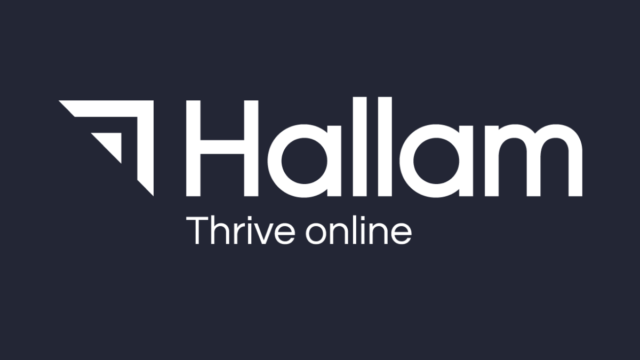Businesses with multiple websites come in several forms. They might be huge international companies, where the separate domains serve totally different business functions. Or, much smaller businesses may have several sites offering the same products or services, in the misguided belief that more websites mean that they’ll have a better chance of succeeding online.
Whether you are a large or small organisation, let’s start by taking a look in a bit more detail at when several domains could be useful, before looking at the disadvantages of such an approach.
Why do businesses have multiple websites?
1. There’s a business case for it
First of all, you should ask yourself why having more than one site is necessary? Is there a reason why this information cannot appear together? It may be the case that there’s a valid business reason for wanting to maintain multiple websites.
In many cases, it can make sense to have several domains, these could include:
- The product/service offering is completely different
- Each domain needs to demonstrate a distinct brand voice.
- The target audience is vastly different
From a user intent perspective, segmenting information may be useful for large organisations with a varied offering. For example;
tesco.com is used to buy groceries

tescobank.com is used for banking

tescoplc.com is a corporate site

Likewise, easyjet.com, easyhotel.com and easycar.com all serve completely different customer needs.
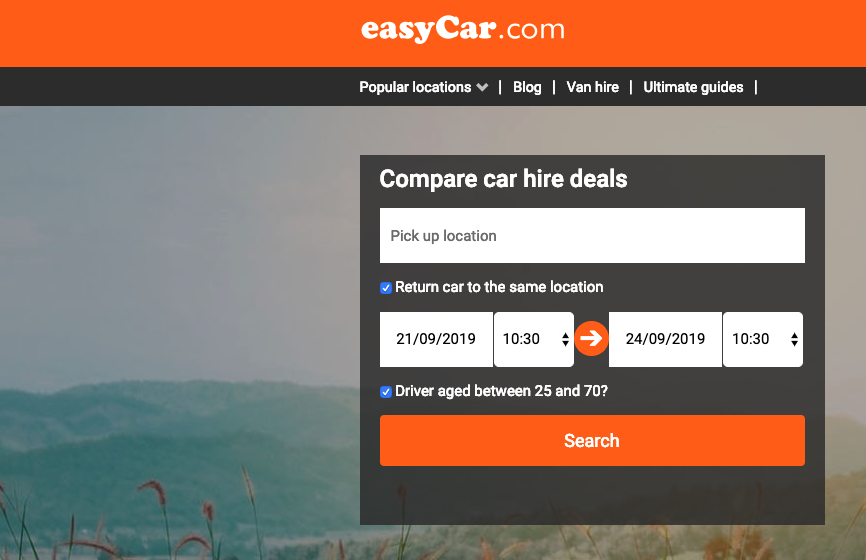
Additionally, some companies may wish to keep intent funnels completely separate and keep lengthy informational content away from the sales-focused ecommerce site.
Although it makes sense for big companies like Tesco, EasyGroup and Virgin to follow this approach, in some cases smaller businesses could also offer a few totally distinct services, where it would make sense for the different offerings to have separate websites.
2. They have multiple websites targeting different countries
There are a number of options to consider when it comes to choosing how to structure international websites.
One of the options that results in multiple sites is using a country code top-level domain name (ccTLD) such as:
- www.ebay.fr – France
- www.ebay.de – Germany
- www.ebay.es – Spain
With a structure like this, each international site will be treated as a separate domain, with separate domain authority and the demands on resource and maintenance that this brings. We will cover resource and maintenance across multiple websites for one business in more detail later on.
For a more in-depth guide of how to rank well in the international market, check out our international SEO checklist.
3. There are compelling technical reasons
Although not a separate domain, it’s fairly common to see a blog hosted on a subdomain (blog.example.com).
Go Outdoors have implemented this strategy with their e-commerce website found at https://www.gooutdoors.co.uk/ and their content found on separately on https://blog.gooutdoors.co.uk/.

It is important to highlight that in an ideal world, the blog would be hosted on the main domain in a subfolder (example.com/blog). If you are using a subdomain Google will view this as a separate site to your main domain. Thus, the valuable authority you have built on your main domain will not be shared with your subdomain. However, it may be the case that technical limitations mean it is impossible to publish content on the main site.
Taken to the next level, some companies who are unable to publish content on their main site may launch an entirely separate domain purely for publishing content, on a nice and easy WordPress platform, or something similar.
4. Having several websites can allow you to dominate the search results
Whilst this technique isn’t widespread, it is popular with many large companies and is known as implementing a multiple domain strategy. In June this year, Google announced an update that targeted site diversity in search.
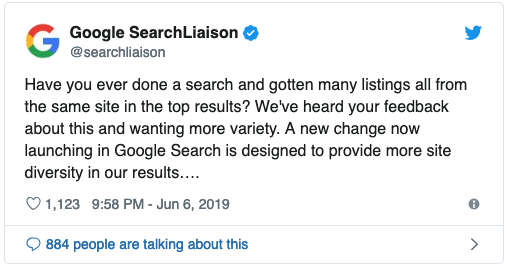
With Google now officially listing only two results max per domain for most queries, having several websites allows you to take up more space in the SERPs for competitive keywords – therefore multiplying your chances of users clicking through, or so the theory goes.
While this might work, you should question whether you have the resource available to get two websites ranking on the first page, let alone one.
SEO guru, Rand Fiskin addressed this in his Moz Whiteboard Friday, highlighting that smaller businesses will struggle to devote the time and money necessary to earn the necessary link equity and rank well for competitive terms.
5. Exact match domain
There is much debate in the SEO community about the importance of a keyword being in the domain name. A recent study by SparkToro asked 1,500+ Professional SEOs how much weight each ranking factor has in Google’s organic ranking system.
‘Keyword in the domain name’ came out as one of the least important ranking factors. Crucially, however, it came out top of ranking factors by relative disagreement.
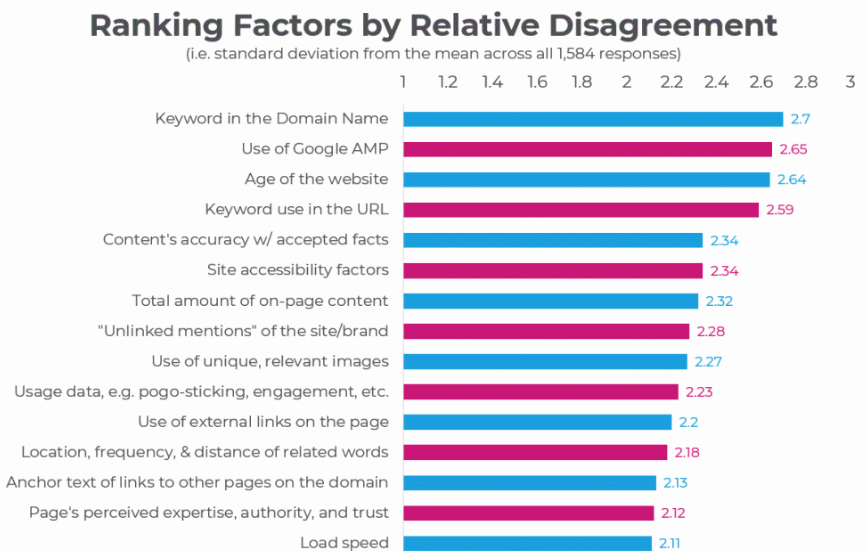
This means that some SEO professionals felt very strongly that ‘keyword in the domain name’ had a large impact whilst others believed it had very little.
The truth is most likely somewhere in between, it probably has more of an impact in traditionally ‘spammy’ industries for local SEO such as locksmith services and less of an impact in areas such as financial services. A Google update in 2012 aimed to counteract the boost you get from exact match domains.
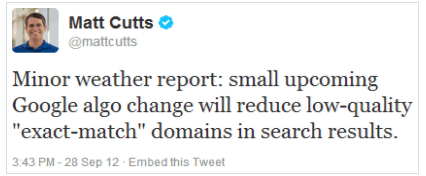
Therefore, as Google’s algorithm improves with each update, the focus on high-quality, content that matches the user intent will mean exact match domains will continue to have less of an impact on rankings than other more important factors.
Nevertheless, as an SEO strategy, some businesses may have attempted to capitalise on the rankings boost given by exact match domains and bought up several exact match domains related to their business, or maybe simply to prevent competitors owning those domains. There are some caveats to consider when purchasing an exact match domain:
- It has to be a quality one – not spammy
- Most of these will have already been bought
- Most likely you’ll have to shell out money to purchase them
Occasionally you might see the same local business with multiple exact match domains dedicated solely to targeting different areas, for example,
- nottinghamplumber.co.uk
- derbyplumber.co.uk.
This is ultimately a bad idea, again stemming back to the resource required, never mind the fact that it’s an approach which aims to deceive the user.
A short-sighted tactic would be to buy multiple exact match domains as a quick way to pass on link equity. This won’t work though, as to pass on any value in a link, the linking site itself needs to have high authority, built over time by earning links.
Essentially, for long-term gain, you are better off focusing your efforts on one quality website rather than buying multiple, low-quality exact match domains.
Why multiple websites may be a bad idea
1. Resource intensive
Perhaps the main and simplest reason that you don’t want multiple websites for one business is that it’s resource-intensive.
Whether it’s content creation, securing SSL certificates, optimising site speed or ensuring the sites are mobile-friendly, your tasks are doubled, and in a few years’ time when it’s about due for a redesign and update, you’ll need to fork out the money for two new websites instead of one.
Most importantly, external links are essential to a site ranking well, and without them, it’s going to be incredibly difficult to rank.
Making a second website means that you’ll have to go through the effort of building links to two websites, rather than focusing your efforts on building up the authority of one site, and if you’ve bought a brand new domain, it’ll be starting with zero authority.
2. Customer confusion and UX
If you’re jumping between multiple websites, it can be confusing, negatively impact UX and may even leave users unaware that they’re viewing the same business.

If you’ve set up multiple websites for the same product but targeting different stages of the conversion funnel, you can’t guarantee that the user will find the right site at the right time. You’d be better off focusing on ensuring that one primary site is as visible as possible and that it has everything a customer needs.
3. Duplicate/thin content
With multiple websites for one business, if you’re showcasing the same products or service offerings there is a clear danger of duplicate content.
For smaller businesses, it’s likely that any microsites or secondary websites will repurpose content from the main site, and if you’re only ‘spinning’ content, you should question why there’s any point in having a separate site in the first place.
Great content is universally agreed upon as being essential to ranking well but it’s unlikely you’ll meet this criteria if the content is very similar or thin.
4. Tracking
With multiple domains for the same business, you have multiple analytics properties to track and manage.
Not only that, but you can lose valuable insight too: when a user navigates between your websites, the source will show as a ‘referral’ – not the source that originally brought the user to your business.

5. Name Address Phone (NAP) Consistency
This one’s more relevant to brick and mortar businesses – if one business operating from one location has multiple websites and each one lists the same business name, address and phone number, this can have a negative effect in search. More importantly, it’s confusing for users.
Google needs consistent NAP information in order to validate your location and return your site in local searches and the local pack. Sending it mixed signals over what domain is linked to a certain location isn’t going to help.
The best approach…
If you have multiple websites, or are considering building more, ask yourself why having more than one site is necessary. If you can’t come up with a good answer and are wondering how best to deal with them, consider merging several domains.
There might be a legitimate business case for maintaining several domains, that’s fine, but leads on to the next point – do you have the resource required for all of them to be effective? While multinational organisations might have the means to operate several successful websites, it’s unlikely that smaller organisations could do so in a way that’s more beneficial than having one strong, authoritative domain.
Still unsure of the best approach for your business? Get in touch with us today and speak to a member of our SEO team.


